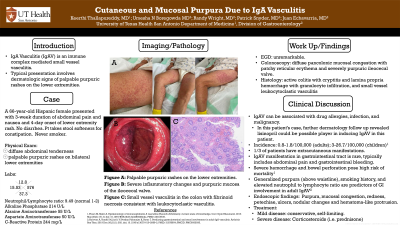Sunday Poster Session
Category: Colon
P0349 - Cutaneous and Mucosal Purpura Due to IgA Vasculitis
Sunday, October 27, 2024
3:30 PM - 7:00 PM ET
Location: Exhibit Hall E

Has Audio

Keerthi Thallapureddy, MD
University of Texas Health San Antonio
San Antonio, TX
Presenting Author(s)
Keerthi Thallapureddy, MD, Umesha Naragalu, MD, Randy Wright, MD, Patrick Snyder, MD, Juan Echavarria, MD
University of Texas Health San Antonio, San Antonio, TX
Introduction: IgA vasculitis (IgAV) is an immune complex mediated small vessel vasculitis characterized by granulocyte recruitment and vascular injury leading to serum exudation and fibrinoid necrosis We present a case of an elderly female who was found to have symptomatic IgAV involving the colon.
Case Description/Methods: A 66-year-old Hispanic female with a history of breast cancer in remission presented with a three week duration of abdominal pain and nausea and a four day onset of lower extremity rash. Physical exam revealed diffuse abdominal tenderness and palpable purpuric rashes on bilateral lower extremities. Labs were notable for leukocytosis and elevated transaminases, C-reactive protein, and sedimentation rate. Upper endoscopy was unremarkable. Colonoscopy showed diffuse colonic mucosal congestion with patchy reticular erythema and severely purpuric ileocecal valve. Histology revealed active colitis with cryptitis and lamina propria hemorrhage with granulocyte infiltration, consistent with leukocytoclastic vasculitis, with similar findings on skin biopsy. She was diagnosed with IgAV with colonic involvement. The patient’s symptoms resolved with initiation of prednisone.
Discussion: IgAV can be associated with drug allergies, infection, and malignancy with an incidence of 45 per million. Typically, patients present with palpable purpuric rashes on the lower extremities. A third of the patients have extracutaneous manifestations. IgAV can rarely manifest in the gastrointestinal tract and can present with abdominal pain and gastrointestinal bleeding. Severe GI involvement includes bowel ischemia leading to tissue necrosis and perforation or bleeding which can be a major source of morbidity and mortality. Endoscopic findings of purpura are similar to that found on skin. Additional endoscopic findings of IgAV in stomach and duodenum include mucosal congestion, redness, petechial, multiple ulcers, nodular change and hematoma-like protrusion. Treatment for GI involvement of IgAV is generally conservative as it can be self-limiting. However, corticosteroids can be used to treat severe cases.

Disclosures:
Keerthi Thallapureddy, MD, Umesha Naragalu, MD, Randy Wright, MD, Patrick Snyder, MD, Juan Echavarria, MD. P0349 - Cutaneous and Mucosal Purpura Due to IgA Vasculitis, ACG 2024 Annual Scientific Meeting Abstracts. Philadelphia, PA: American College of Gastroenterology.
University of Texas Health San Antonio, San Antonio, TX
Introduction: IgA vasculitis (IgAV) is an immune complex mediated small vessel vasculitis characterized by granulocyte recruitment and vascular injury leading to serum exudation and fibrinoid necrosis We present a case of an elderly female who was found to have symptomatic IgAV involving the colon.
Case Description/Methods: A 66-year-old Hispanic female with a history of breast cancer in remission presented with a three week duration of abdominal pain and nausea and a four day onset of lower extremity rash. Physical exam revealed diffuse abdominal tenderness and palpable purpuric rashes on bilateral lower extremities. Labs were notable for leukocytosis and elevated transaminases, C-reactive protein, and sedimentation rate. Upper endoscopy was unremarkable. Colonoscopy showed diffuse colonic mucosal congestion with patchy reticular erythema and severely purpuric ileocecal valve. Histology revealed active colitis with cryptitis and lamina propria hemorrhage with granulocyte infiltration, consistent with leukocytoclastic vasculitis, with similar findings on skin biopsy. She was diagnosed with IgAV with colonic involvement. The patient’s symptoms resolved with initiation of prednisone.
Discussion: IgAV can be associated with drug allergies, infection, and malignancy with an incidence of 45 per million. Typically, patients present with palpable purpuric rashes on the lower extremities. A third of the patients have extracutaneous manifestations. IgAV can rarely manifest in the gastrointestinal tract and can present with abdominal pain and gastrointestinal bleeding. Severe GI involvement includes bowel ischemia leading to tissue necrosis and perforation or bleeding which can be a major source of morbidity and mortality. Endoscopic findings of purpura are similar to that found on skin. Additional endoscopic findings of IgAV in stomach and duodenum include mucosal congestion, redness, petechial, multiple ulcers, nodular change and hematoma-like protrusion. Treatment for GI involvement of IgAV is generally conservative as it can be self-limiting. However, corticosteroids can be used to treat severe cases.

Figure: Figure A: Palpable purpuric rashes on the lower extremities.
Figure B: Severe inflammatory changes and purpuric mucosa of the ileocecal valve.
Figure C: Small vessel vasculitis in the colon with fibrinoid necrosis consistent with leukocytoclastic vasculitis.
Figure B: Severe inflammatory changes and purpuric mucosa of the ileocecal valve.
Figure C: Small vessel vasculitis in the colon with fibrinoid necrosis consistent with leukocytoclastic vasculitis.
Disclosures:
Keerthi Thallapureddy indicated no relevant financial relationships.
Umesha Naragalu indicated no relevant financial relationships.
Randy Wright indicated no relevant financial relationships.
Patrick Snyder indicated no relevant financial relationships.
Juan Echavarria indicated no relevant financial relationships.
Keerthi Thallapureddy, MD, Umesha Naragalu, MD, Randy Wright, MD, Patrick Snyder, MD, Juan Echavarria, MD. P0349 - Cutaneous and Mucosal Purpura Due to IgA Vasculitis, ACG 2024 Annual Scientific Meeting Abstracts. Philadelphia, PA: American College of Gastroenterology.
